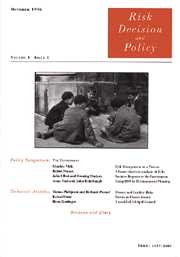Article contents
Societal risk and societal benefits
Published online by Cambridge University Press: 22 May 2002
Abstract
Decisions based on risk analysis require some form of risk acceptance criteria. Presently the International Maritime Organisation (IMO) has initiated an activity on developing a risk-based approach to safety and environmental protection regulations. Explicit risk estimates are new to the organisation. A limited number of FSA trial apllications have been presented so far. Whilst giving increased general knowledge of the risk level in the industry, the debate about risk acceptance has just started.
The objective of this paper is to outline an approach by which societal risk acceptance criteria may be established. The idea is to discriminate between activities representing different risks and importance to society. The societal risk acceptance criteria are calibrated against occupational fatality rates, and transportation fatality rate for scheduled air traffic worldwide. Examples are given for some different ship types. For the sake of discussion a societal risk acceptance for Near Earth objects colliding with the Earth is also derived. It should be noted that many other criteria would be needed in the decision process, like for example individual risks, criteria based on cost effectiveness, and criteria for environmental consequences. Normally a decision would have to be based on acceptance by all these criteria. Only one specific method to arrive at societal risk criteria is dealt with herein. The examples given for some ship types show that when the importance to the society is accounted for, the established FN acceptance curves vary within 1 to 2 orders of magnitude.
The outlined method may be considered for any type of activity above a certain size. An obvious limitation for the method is represented by activities of high economic value with low labour intensity in remote places, for example exploitation of offshore oil and gas resources.
- Type
- Technical Article
- Information
- Copyright
- © Risk Decision and Policy, 2002
- 6
- Cited by




